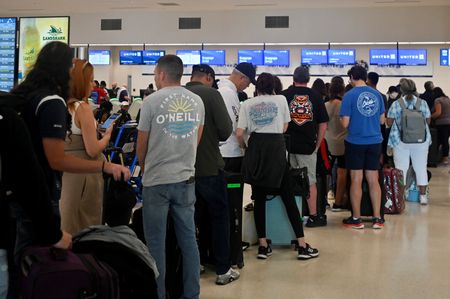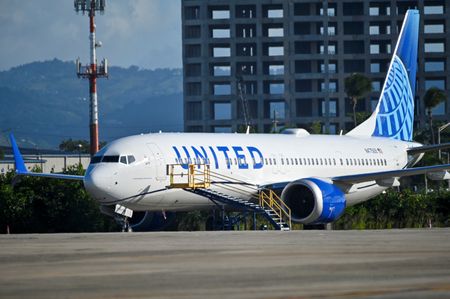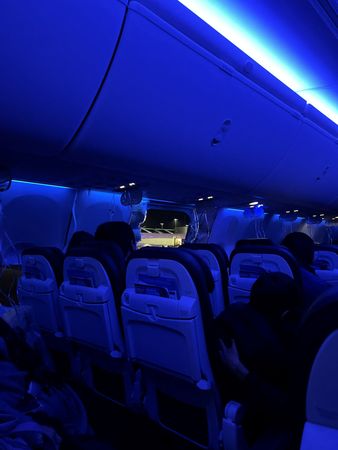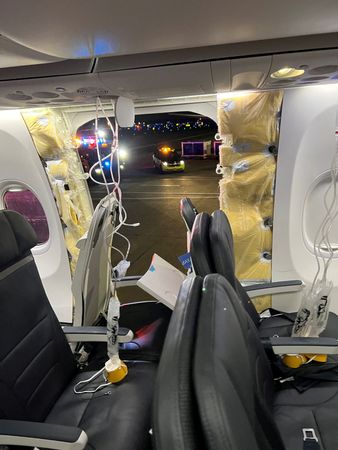By David Shepardson, Valerie Insinna and Tim Hepher
(Reuters) – Safety checks on some Boeing jets hit a snag over paperwork on Sunday, as U.S. authorities searched for a missing panel that blew off a new Boeing 737 MAX 9 jet in midair on Friday.
The Federal Aviation Administration on Saturday ordered the temporary grounding of 171 Boeing jets installed with the same panel after the eight-week-old Alaska Airlines jet was forced to make an emergency landing with a gap in the fuselage.
“They will remain grounded until the FAA is satisfied that they are safe,” the agency said in a statement on Sunday.
The door plug tore off the left side of an Alaska Airlines jet following takeoff from Portland, Oregon, en route to Ontario, California, forcing pilots to turn back and land safely with all 171 passengers and six crew on board.
The force of the 737 MAX 9 decompression was so strong it blew open the cockpit door, according to a person briefed on the investigation.
The accident has put Boeing back under scrutiny as it awaits certification of its smaller MAX 7 as well as the larger MAX 10, which is needed to compete with a key Airbus model.
On Saturday, the FAA initially said the required inspections would take four to eight hours, leading many in the industry to assume the planes could very quickly return to service.
But criteria for the checks have yet to be agreed between the FAA and Boeing, meaning airlines have yet to receive detailed instructions, people familiar with the matter said.
The FAA must approve Boeing’s inspection criteria before inspections can be completed and planes can resume flights.
Of the 171 planes covered by the order, 144 are operating in the United States, according to data from aviation analytics firm Cirium. Turkish Airlines, Panama’s Copa Airlines and Aeromexico said they were grounding affected jets.
Typically, whenever planemakers order routine maintenance checks, they get paperwork approved by regulators in advance.
But because the response to the unexpected Alaska Airlines incident was relatively swift, Boeing has not yet secured FAA approval to tell airlines how to carry out the regulator’s order.
The FAA has the final word on how the order is implemented.
FLIGHTS CANCELED
Alaska Airlines said on Sunday it was “just waiting for the direction from the FAA and Boeing so our inspections can begin.” The airline canceled 170 flights affecting nearly 25,000 customers and said travel disruptions from the grounding were expected to last through at least midweek.
United Airlines canceled 230 flights on Sunday, or 8% of scheduled departures, after parking all 79 of its 737 MAX 9s awaiting the inspection directions.
“We’ve begun steps such as removing the inner panel to access the emergency door, and begun preliminary inspections while awaiting final instructions,” United said in a statement.
Boeing declined to comment on whether it had submitted its inspection criteria to the FAA, which had no further comment.
In message to employees on Sunday, Boeing CEO Dave Calhoun said the company’s response to the accident must be the team’s focus right now.
“When serious accidents like this occur, it is critical for us to work transparently with our customers and regulators to understand and address the causes of the event, and to ensure they don’t happen again,” Calhoun said.
The company plans to hold a company-wide webcast on safety on Tuesday to address its response. It also canceled a leadership summit for company vice presidents previously scheduled for Monday and Tuesday.
SEARCH FOR PANEL
It is too early to say what caused Friday’s event, National Transportation Safety Board (NTSB) Chair Jennifer Homendy told reporters on Saturday.
The aircraft panel is likely to have landed somewhere in the western suburbs of Portland, but has not yet been found.
The NTSB has asked the public for help finding the panel and also plans to ask commercial property owners to check the rooftops of industrial buildings in the area.
The extra exit door is typically installed by low-cost airlines using more seats that require additional evacuation routes. However, those doors are plugged on jets with fewer seats like the Alaska Airlines plane. To passengers, the area looks like a normal window seat.
A cell phone was located Sunday in the search area that may have blown out of the plane, according to the person familiar with the investigation.
In 2019, global authorities subjected all MAX planes to a wider grounding that lasted 20 months after crashes in Ethiopia and Indonesia linked to poorly designed cockpit software killed a total of 346 people.
Boeing has delivered 214 of the 737 MAX 9 model, or 15% of the more than 1,300 MAX aircraft in service, most of which can still fly, including 737 MAX 9 jets with ordinary doors instead of the replacement panels.
CABIN ISSUES
The fuselage for Boeing 737s is made by Kansas-based Spirit AeroSystems, which also manufactured and installed the plug that suffered the blowout.
Sources familiar with the process said Boeing also has a potential role, since it typically removes the semi-fitted door panel after receiving the fuselages by rail from Spirit. It uses the gap to feed in cabin equipment and speed up production, before completing final installation.
Spirit referred questions to Boeing, which did not respond to a request for comment on who carried out final installation.
(Reporting by David Shepardson, Valerie Insinna and Tim Hepher; Additional reporting by Lisa Barrington and Hannah Lang; Editing by Bill Berkrot, Jonathan Oatis and Jamie Freed)















